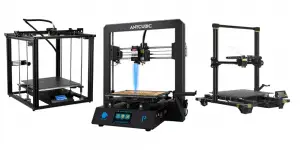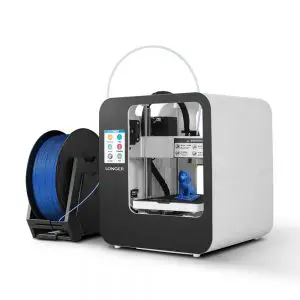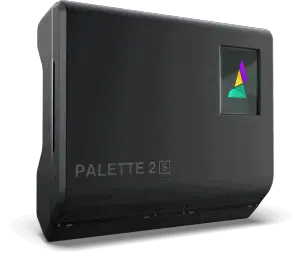3D printing is also known as additive manufacturing. It is a manufacturing process where a 3D printer creates 3-dimensional objects. The printer builds these 3-dimensional objects layer by layer. Computer software creates instructions for how each layer will make up the 3D model. Plastics and metal alloys are the most used materials but there are many others.
How Does 3D Printing Work?
Quick History of 3D Printing
3D printing has an interesting history, to say the least. In 1984, Chuck Hull of 3D Systems Corporation filed a patent for a stereolithography fabrication system. With this system, layers are created by curing photopolymers with ultraviolet light lasers. Hull defined the process as a “system for generating three-dimensional objects by creating a cross-sectional pattern of the object to be formed”. Hull is responsible for the STL (Stereolithography) file formation. He also created a digital slicing and infill strategy that is still used today.
In 1988, the technology used by most hobbyist and consumer-based 3D printers today was developed by S. Scott Crump. This technology is called fused deposition modeling or FDM. It was commercialized by Crump’s company and marketed as the first FDM machine.
In 2009, the patents on the FDM printing process expired which lead to large drops in price. As a result, the first low cost desktop 3D printers became available. Not only that, they were at prices that everyday people could afford.
Since 2009, 3D printing technology has grown and developed in many ways. There are now machines that are able to print with a wider range of materials. Now, 3D printing is used more in production for hobbyists, designers and companies worldwide.
3D Modeling Software
There are several ways that 3D printable models can be designed. With computer-aided design (CAD), 3D scanners, or digital camera and photogrammetry software. Let’s briefly review them so you have an idea of what they are.
Computer-aided Design (CAD)
This is software that allows for the design of 3D models. One of the great things about using CAD to create printed models is that it can greatly reduce errors. Errors that would otherwise not be corrected before printing.
3D Scanning
3D scanning is a technology that digitally captures the entire shape of physical objects using a line of laser light. They create “point clouds” of data from the surface of the object. In essence, 3D scanning captures the physical objects of an exact size and shape. It then digitizes the information into a digital 3-dimensional representation on a computer.
Photogrammetry
Photogrammetry is a method designed to extract 3D information from photographs. It is a special process that involves taking overlapping photographs of an object, structure, or space. Once these photographs are capture they are converted to 2D or 3D digital models. In creating 3D models, a digital camera is often used.
Slicing: Digital 3D Model to 3D Printer
Once the 3D digital model has been created it must be prepared for 3D printing. It is divided into hundreds if not thousands of horizontal layers. Slicing software is used to achieve this. Many 3D printers come with built-in slicers and let you use raw files from your modeling software. Once the file has been properly sliced, it’s ready for printing.
Types of 3D Printing
There are many ways to 3D print. It’s important to note that these technologies are additive manufacturing processes. They largely differ in the way that they build layers to create objects.
A set of standards have been created to classify the Additive Manufacturing processes into 7 categories. These standards were established by the American Society for Testing and Materials group “ASTM F42- Additive Manufacturing.
The seven categories are:
- Material Extrusion – Material that is selectively dispensed through a nozzle or orifice
-
- Fused Deposition Modeling (FDM)
- Fused Filament Fabrication (FFF)
- Vat Polymerization – Photopolymer liquid in a vat that is selectively cured by UV light
- Stereolithography (SLA)
-
- Digital Light Processing (DLP)
-
- Continuous Liquid Interface Production (CLIP)
- Powder Bed Fusion – Selectively fusing of powder particles via a high energy source
-
- Multi Jet Fusion (MJF)
-
- Selective Laser Sintering (SLS)
-
- Direct Metal Laser Sintering (DMLS)
- Material Jetting – Drops of material are selectively deposited and then cured
- Binder Jetting – liquid bonding agent is used to selectively bind regions of a powder bed
- Direct Energy Deposition – Material is fused via a high energy source as it is deposited
- Sheet Lamination – Sheets of material are bonded and created one layer at a time
What is 3D Printing Used For?
In recent years, 3D printing has continued to develop. Today, it can now execute important roles in many applications. Most commonly, it is used in manufacturing, architecture, medicine, and even custom art and design. For many years 3D printing came at a high price, however now this is finally changing. These changes in price are having a positive impact on several industries. Let’s review a few of the most common.
Manufacturing
With additive manufacturing technology starting in the 1980’s it has had many years to expand into several areas. These areas include product development, rapid prototyping and data visualization. There have also been tremendous strides in production. With these strides have come other popular applications in industries which include architecture, construction, aerospace, dental, medical, fashion, jewelry and more.
Medical
When it comes to medical applications 3D printing can blow your mind. Many uses for the medical field are used for anatomical modeling for bony reconstructive surgery. With these advances in technology, patients are able to have implants tailored for them. Implants that are personalized and unique to their anatomy. Other medical implants include those that are even biodegradable and are designed to break down in the body over a period of 6 months to 2 years. These forms of implants include rods, pins, screws.
Automotive
In other areas such as the automotive space companies are now using 3D printing every day. It has become an essential part of manufacturing. Industrial 3D printers have paved the way for just about every stage of the production of automobiles. From creating functional prototypes, designs and tooling production to actual part manufacturing.
Architecture
Lets’ face it, architecture is also another place where 3D printing shines. Architects are using 3D printers to produce stunning, physical and detailed architectural models. This technology allows them to showcase their ideas, impress clients, and provide tangible models. This, in turn, gives them the power to pitch and close deals. Not only does the ability to create 3D models in the house save time, but it also saves money. There are typically several teams of people involved in architecture or construction projects. Not just builders and planners. 3D architectural models allow teams to share ideas, communicate and collaborate. All while limiting confusion or misunderstanding.
What Materials are Available for 3D Printing?
The number of materials available for 3D printing continues to grow each year. The fact still remains that plastic is still the most commonly used material to date. Following behind plastic is metal. Other materials include, nylon, glass, resins, wood, sandstone and carbon fiber.
What Type of Filament to use?
For the most part, just about every 3D printer will accept two of the most common filaments. These are PLA and ABS filaments. To keep it simple, both of these filaments are plastics. They both have different properties that make them very different. You’ll want to think about what you plan on printing beforehand as they both will have pros and cons when considering the end product.
As you approach the mid-range level of printers you will find that they do accept a wider selection of materials. Be sure that you educate yourself on each material and model before purchasing one. Furthermore, it’s important to take note of which printers use proprietary filament and the ones that don’t. Having limited options for filament types can spell trouble down the line. With fewer options, you’ll likely spend more money. Not to mention you’ll be at the printer company’s mercy should they decide to stop production for any reason.
Conclusion
3D printing is a thrilling technology that has been around for many years. Prices for consumer-based models continue to drop each year. They become more available for hobbyists, designers, and everyday people. After reading this article you might be thinking, why buy a 3d printer? Well, with the information found here on our site and other places across the web you’ll be fully equipped to jump right in.







